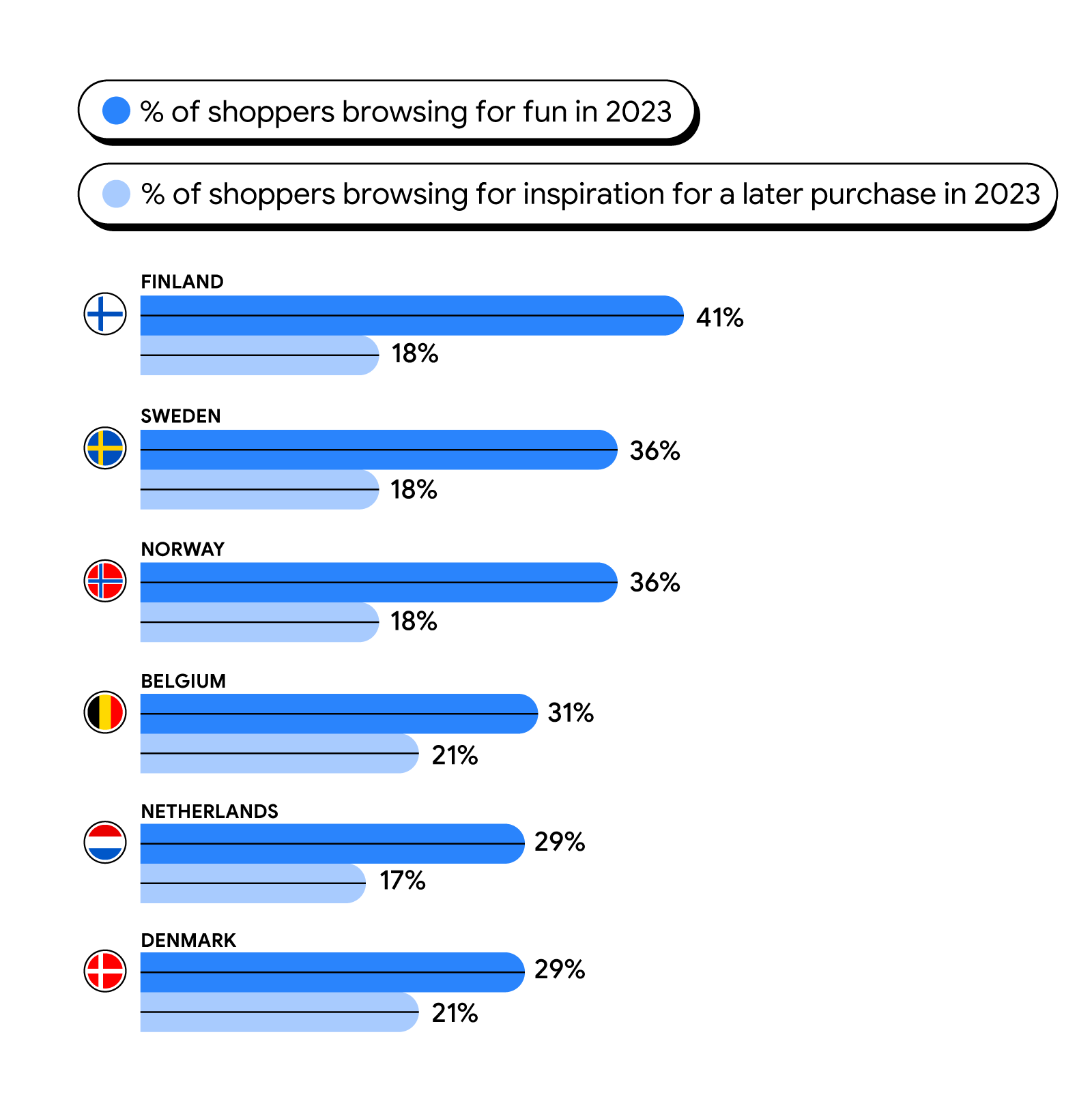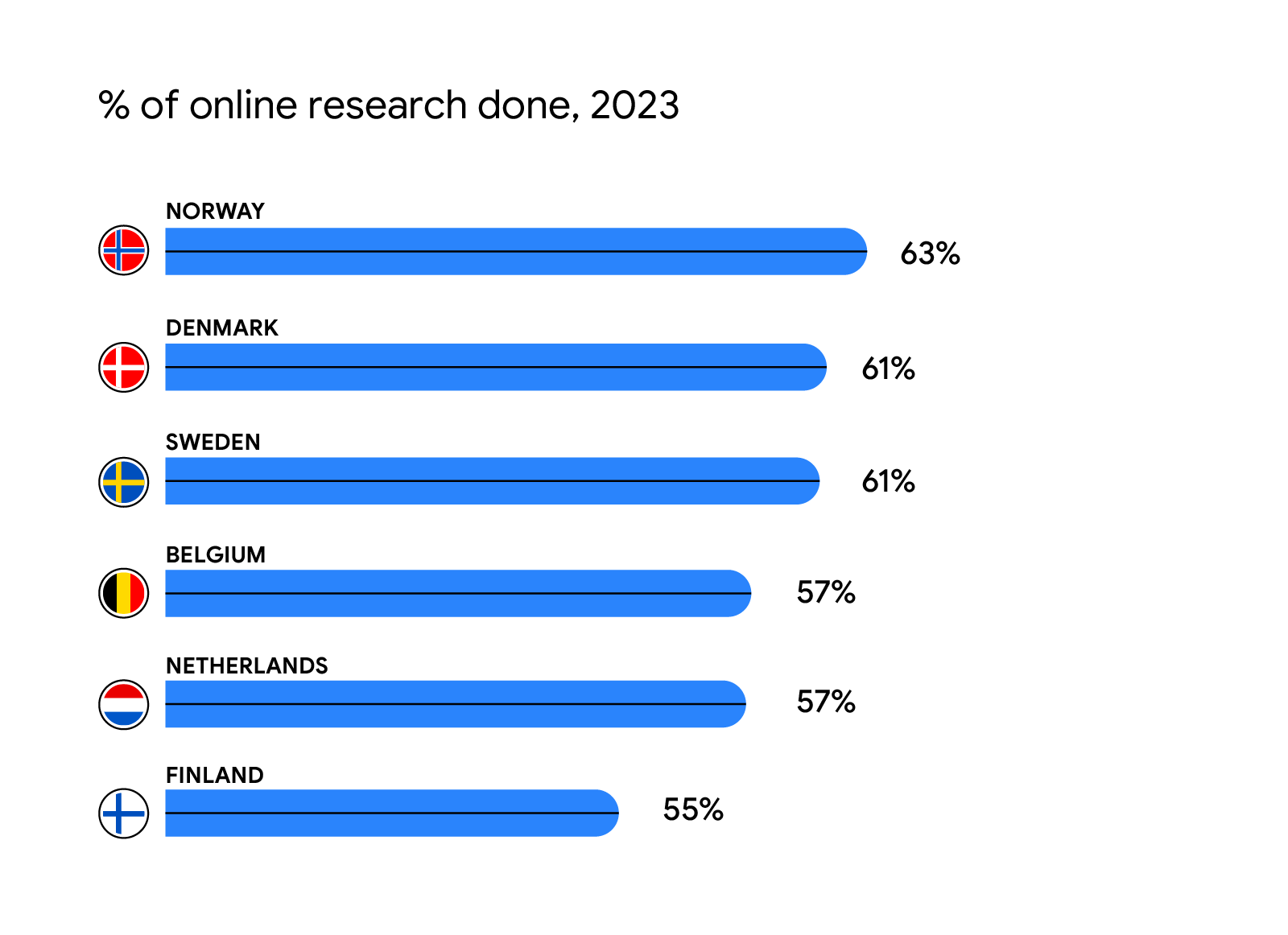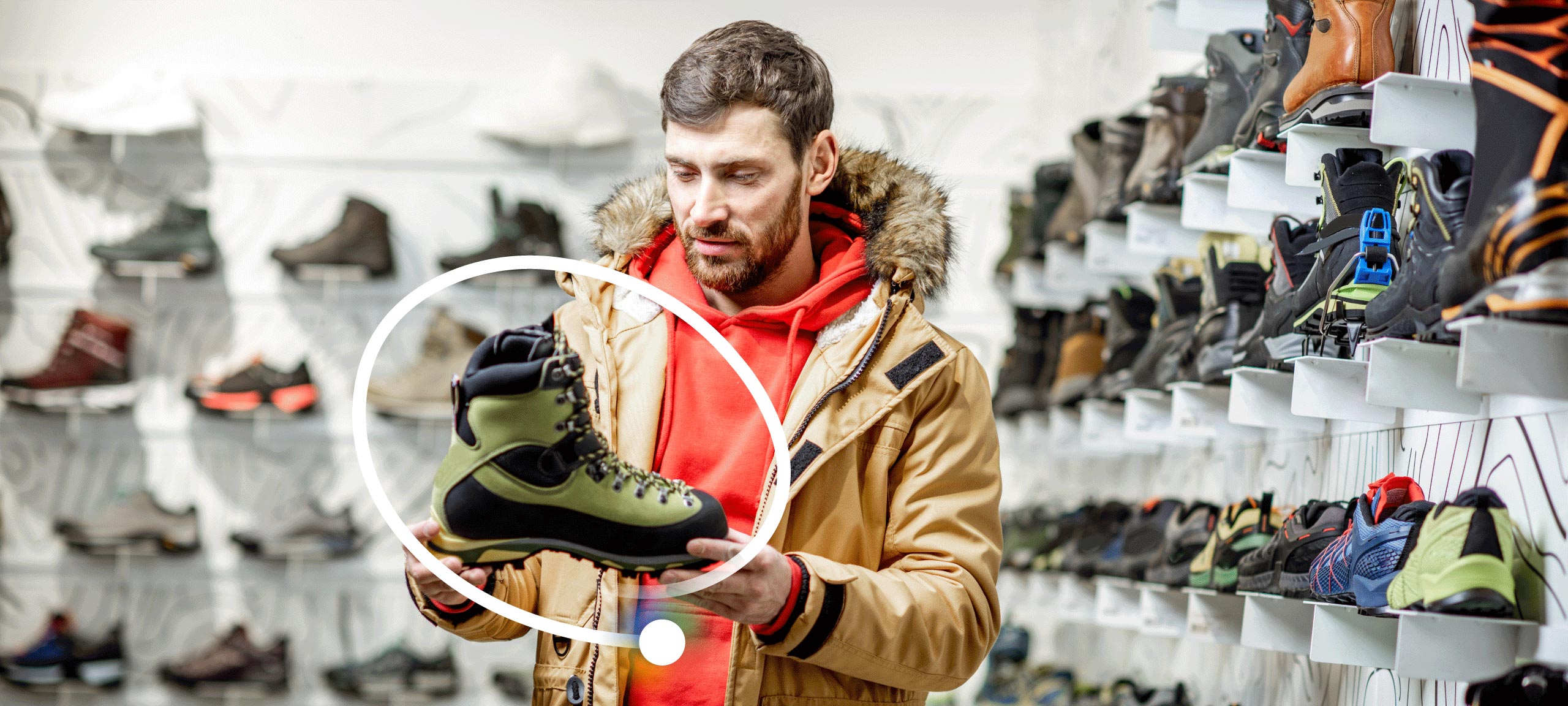With Dutch inflation looking set to decrease over 2024 and retail confidence on the rise, there’s never been a better time to look for new ways to entice customers.
The latest retail insights from Google reveal how to succeed in 2024. With a view of over 30 markets, seven shopping categories, and five years worth of data, it provides a must-read guide to what matters most to Nordic and Benelux consumers.
Here we reveal how to use that to your competitive advantage.
1. Retailtainment is an emerging trend
Most purchase journeys start with an intent. A customer is in the market for a new television, a piece of clothing, or a piece of jewellery. But what if the journey started pre-intent? What if it started as entertainment.
One of the most surprising insights for retailers might be the amount of consumers searching for fun or browsing to get inspiration for a later purchase. “Retailtainment” is an emerging trend where people are browsing the internet for pleasure, rather than for any item in particular.
In fact, for consumers in Finland this represents up to 41% of survey respondents.

Source: Smart Shopper Research, Google / Cint (2023). Countries: BE, NL, DE, SE, NO, FI. Nationally
representative online population 18+Y.O who conducted purchases in the past 3 months for Consumer Electronics/Home & Garden/Fashion/Toys/Jewellery and in the past 1 month for Food & Groceries/Beauty, Base 2023: All product buyers of CE, Home, Fashion, Food, Beauty, Toys, Jewellery, 2023.
This means there’s a huge opportunity for brands and retailers to be present now, whilst influencing purchase decisions later. You can be a part of the conversation and connect with a consumer, even if they’re not making a purchase immediately.
Key takeaway: The research process is always on, so you need to be always present. Even when people are browsing “for fun” it’s an opportunity to start a connection with them.
Think about someone browsing new electronics, the latest beauty buy, or even food and grocery suggestions. They might not purchase instantly, but by being in the mind of the consumer when they’re looking at inspirational content, you might just become a brand they’ll try later on.
2. The use of technology can increase likelihood of purchase
Now your customer’s had some fun browsing for ideas they might just be in the market to start their active research.
And at this stage, the use of tools and technology, like augmented reality (AR), virtual reality (VR), or using visual search (e.g. Google Lens) are leading the way in the pre-purchase search journey.
Topping the charts for Nordic and Benelux consumers is the use of Short form video content for research, followed by social commerce, visual search, and AR/VR. That means there’s plenty of potential for brands willing to innovate in the formats they use and create new ways to make the shopping experience fun, personalised, and interesting.
Source: Smart Shopper Research, Google / Cint (2023). Countries: BE, NL, DE, SE, NO, FI. Nationally representative online population 18+Y.O who conducted purchases in the past 3 months for Consumer Electronics/Home & Garden/Fashion/Toys/Jewellery and in the past 1 month for Food & Groceries/Beauty, Base 2023: All product buyers of CE, Home, Fashion, Food, Beauty, Toys, Jewellery, Aggregation: % of consumers who used at least one of the following tools/technologies when looking for inspiration about what to buy in the last 6 months: Short Form Videos, Social Commerce, Google Lens, VR, AR, 2023.
Key takeaway: With 28% to 38% of respondents from the Nordics and Benelux using technology in their pre-purchase journey, there’s still a lot retailers in our region can do. Embracing these new touchpoints can help you connect with a new generation of customers and give you fresh ways to engage with them.
3. Online is vital for research for local shoppers
Finally your customer is ready to make a purchase. They’re doing their checks and balances, reading reviews, finding the best price, and looking at brands or retailers they know.
And for consumers in the Benelux and Nordics, much of this happens online. In fact people in our region are likely to have an exclusively online research and purchase journey.
Source: Smart Shopper Research, Google / Cint (2023). Countries: BE, NL, DE, SE, NO, FI. Nationally representative online population 18+Y.O who conducted purchases in the past 3 months for Consumer Electronics/Home & Garden/Fashion/Toys/Jewellery and in the past 1 month for Food & Groceries/Beauty, Base 2023: All product buyers of CE, Home, Fashion, Food, Beauty, Toys, Jewellery - excluding respondents who did no product research before their purchase, 2023.
With 63% of research being done online in Norway retailers need to know how to utilise digital channels like search, social media, and online videos to connect with their customers.

Source: Smart Shopper Research, Google / Cint (2023). Countries: BE, NL, DE, SE, NO, FI. Nationally representative online population 18+Y.O who conducted purchases in the past 3 months for Consumer Electronics/Home & Garden/Fashion/Toys/Jewellery and in the past 1 month for Food & Groceries/Beauty, Base 2023: All product buyers of CE, Home, Fashion, Food, Beauty, Toys, Jewellery, 2023.
Furthermore, how people search online for their next purchase is changing, with the use of modifiers revealing what’s important to them. Search interest for terms containing ‘review’, ‘compare’, ‘inspiration’, ‘near me’, ‘delivery’, and ‘price’ have remained popular in the shopping category in the Netherlands in the last 5 years.
Finally, the time between research to purchase impacts the success of the online search journey, which is shorter for markets in our region compared to the rest of EMEA. So a frictionless shopping experience is a must.
Source: Smart Shopper Research, Google / Cint (2023). Countries: BE, NL, DE, SE, NO, FI. Nationally representative online population 18+Y.O who conducted purchases in the past 3 months for Consumer Electronics/Home & Garden/Fashion/Toys/Jewellery and in the past 1 month for Food & Groceries/Beauty, , Base: Online buyers, 2023.
Key takeaway: Shoppers are highly driven by online research and purchase channels. Consumers are omnichannel and the distinction between on and offline has become blurred. This means retailers should be using online channels to promote in store sales, and vice versa.
4. Pain points will cause your customers to switch off
As your customer is about to press that “buy now” button or head out to the shops, there’s one last thing to consider: Pain points.
The best new technologies and online research experience won’t save retailers if consumers meet barriers. And with 57% experiencing online ‘pain points’ in Belgium alone, for a market that does a lot of their shopping online, this is definitely worth addressing.
Pain points can be things like product unavailability, being unable to complete a purchase without registering, or lack of independent customer reviews.
Source: Smart Shopper Research, Google / Cint (2023). Countries: BE, NL, DE, SE, NO, FI. Nationally representative online population 18+Y.O who conducted purchases in the past 3 months for Consumer Electronics/Home & Garden/Fashion/Toys/Jewellery and in the past 1 month for Food & Groceries/Beauty, Base 2023: Online buyers of CE, Home, Fashion, Food, Beauty, Toys, Jewellery, 2023.
Key takeaway: As customers become more demanding, listen to their needs and address pain points. Make independent reviews easier to find, ensure product availability, or offer solutions like ‘guest checkout’. Assess your shopping experience end-to-end and ensure that it’s as pain-free an experience as possible.





